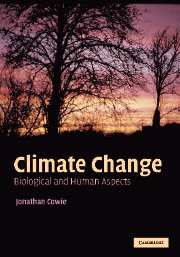Book contents
- Frontmatter
- Contents
- Introduction
- Acknowledgements
- 1 An introduction to climate change
- 2 Principal indicators of past climates
- 3 Past climate change
- 4 The Oligocene to the Quaternary: climate and biology
- 5 Present climate and biological change
- 6 Current warming and likely future impacts
- 7 The human ecology of climate change
- 8 Sustainability and policy
- Appendix 1 Glossary and abbreviations
- Appendix 2 Bio-geological chronology
- Appendix 3 Calculations of energy demand/supply and orders of magnitude
- Appendix 4 The IPCC 2007 report
- Index
- References
5 - Present climate and biological change
Published online by Cambridge University Press: 17 December 2010
- Frontmatter
- Contents
- Introduction
- Acknowledgements
- 1 An introduction to climate change
- 2 Principal indicators of past climates
- 3 Past climate change
- 4 The Oligocene to the Quaternary: climate and biology
- 5 Present climate and biological change
- 6 Current warming and likely future impacts
- 7 The human ecology of climate change
- 8 Sustainability and policy
- Appendix 1 Glossary and abbreviations
- Appendix 2 Bio-geological chronology
- Appendix 3 Calculations of energy demand/supply and orders of magnitude
- Appendix 4 The IPCC 2007 report
- Index
- References
Summary
Recent climate change
The latter half of the Little Ice Age
The seventeenth century was not just in the Little Ice Age, it is also noted (and for some better noted) for the Renaissance in the gathering of scientific understanding which in turn was to drive the Industrial Revolution of the eighteenth and nineteenth centuries. In Britain in the 1640s and 1650s scientists sought what they termed ‘a great insaturation’, which drew on the philosophies exposed by the likes of Francis Bacon. Among these, Bacon's principles of exact observation, measurement and inductive reasoning provided the intellectual tools for scientific advance. These advances had yet to percolate through to day-to-day application in technology, and life, society and its economy were still largely powered by humans and animals together with wood burning. Major global impacts from human activity were not yet manifest (although of course trace global signatures such as metals in Greenland ice cores can be found dating to thousands of years earlier).
In terms of climate and weather 1659, within the Little Ice Age, is an important date. Before that date we rely solely on the proxy indicators (see Chapter 2) for climatic information. After 1659 there began a source of new information: direct meteorological measurement. The first significant series of measurements began in 1659 and (much later) were compiled into a monthly series of temperature readings for rural sites in central England by Gordon Manley (1974): it is the longest homogeneous record and is still kept up to date by the UK Meteorological Office.
- Type
- Chapter
- Information
- Climate ChangeBiological and Human Aspects, pp. 184 - 230Publisher: Cambridge University PressPrint publication year: 2007



